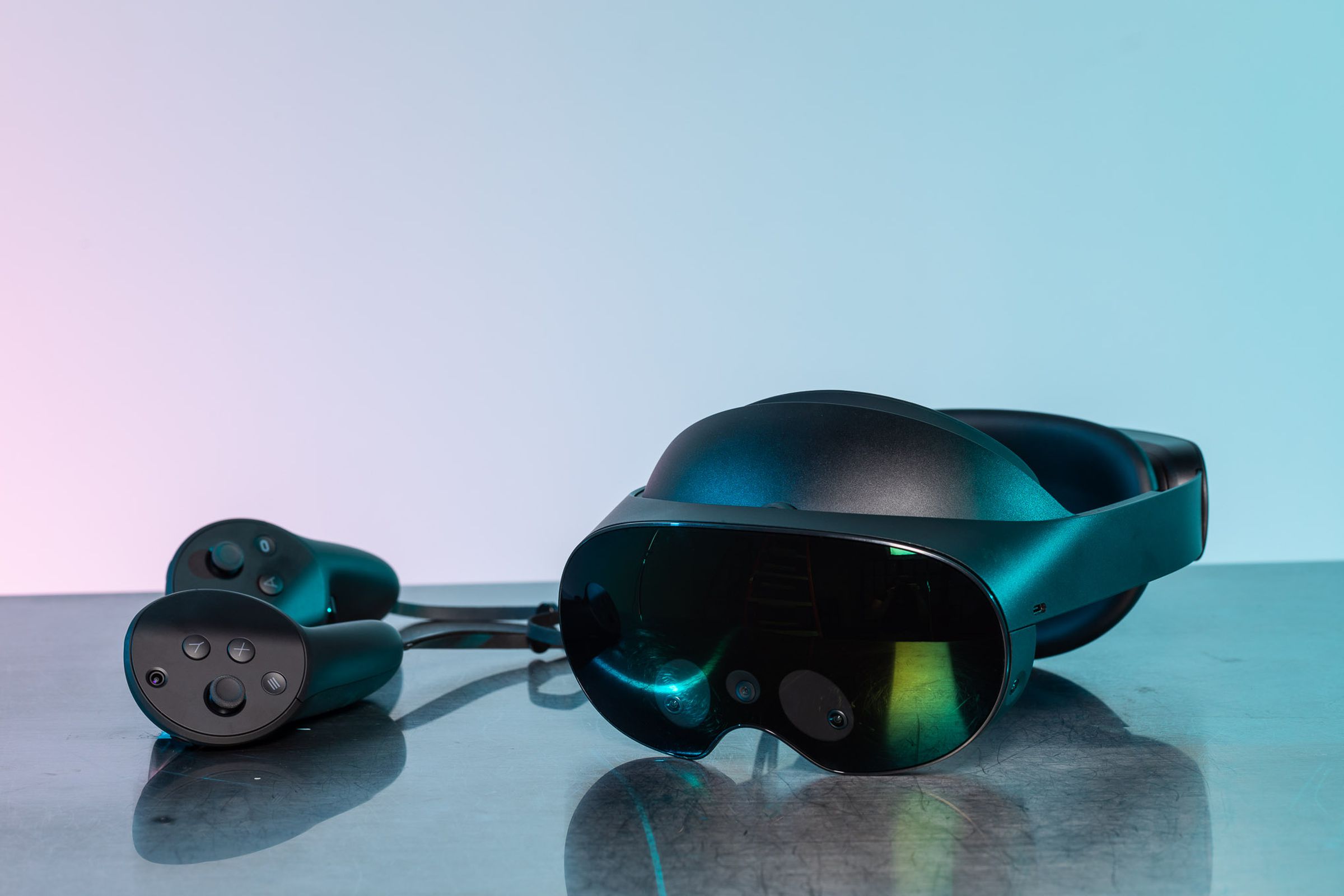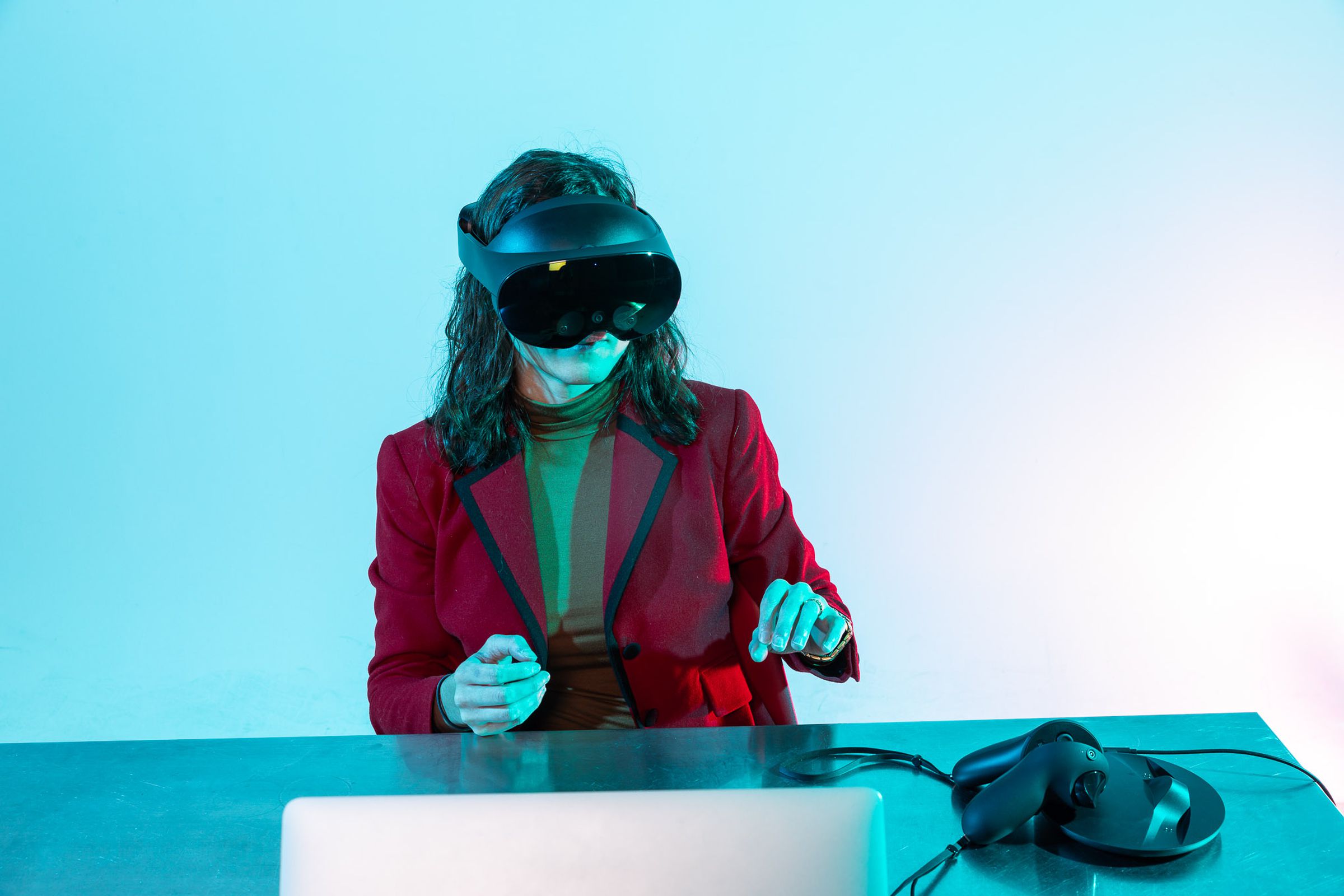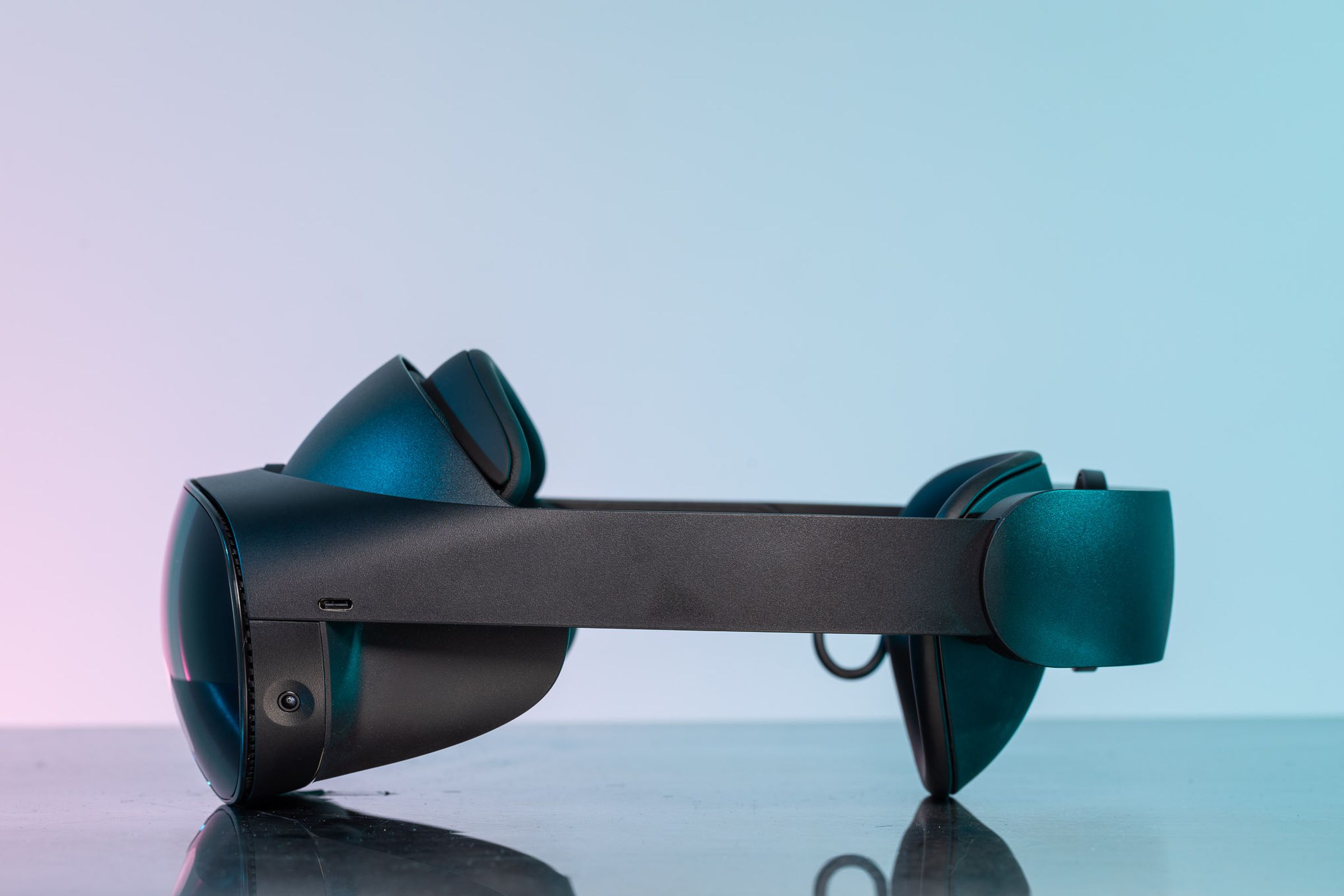Mark Zuckerberg is betting the entire future of his company on the metaverse. He renamed Facebook to Meta last year, and so far this year, he’s spent $10 billion on Reality Labs, Meta’s AR and VR development group. Reality Labs was not cut particularly hard in Meta’s huge layoffs this week, even in the face of pressure to reduce the investment and focus on the core advertising business.
So the Quest Pro, Meta’s new virtual reality headset, is facing a lot of pressure. It has to start delivering on a huge set of promises about the future of work — it’s meant to host meetings, replace big monitors, and create a more lasting sense of connection to other people in VR. Meta has seen modest success with its Quest 2 game console, but the Quest Pro is the start of a new generation of computers: a $1,499 product designed to run Microsoft software and sold by Accenture.
The problem is, the Quest Pro isn’t very good. It’s a device seemingly launched without plan or purpose, highlighting VR’s persistent drawbacks without making good use of its strengths — and topped off with some irredeemably bad software. We might be seeing a roadmap for where Meta is going, but right now, it’s not a particularly fun place to be. And if Meta lingers there much longer, its metaverse is in trouble.
The Meta Quest Pro is a high-end alternative to the Quest 2, which Meta will continue to sell separately. It’s a self-contained VR headset with beefier internal specs and two major new features: mixed reality with a full-color video feed and face tracking via inward-facing cameras. Meta imagines the Quest Pro as a virtual office where people can meet up with co-workers and toggle between full VR and a limited form of AR.
While Meta has described the Quest as a VR Nintendo Switch, it’s tailoring the Quest Pro to an audience that can buy a more expensive headset, starting with its looks and fit. The Quest Pro is an intimidatingly polished-looking piece of black plastic. Instead of the Quest 2’s cloth straps, it features a black plastic halo, which sits around your head and tightens with a wheel at the back, a bit like the original PlayStation VR. The headset is heavier than the Quest 2 at 722 grams compared to 503 grams, but it’s redistributed its weight to be less front-heavy, shifting its battery to the back.

I loved this design after a Quest Pro demo session, and I think it’s still got strong points. The headset fits more securely than the default Quest 2 strap system, which sometimes felt on the verge of slipping off. There’s no velcro for my long hair to get caught in.
But since that first demo, using the Quest Pro has become uniquely tortuous. Its ring puts practically all its substantial weight on my upper forehead, sometimes leaving a numb and tingling strip along my hairline. It feels a little better if I keep the fit loose, but that makes the headset less stable during games and other high-intensity activities. It’s a worse experience than the Quest 2 with its optional Elite Strap, which includes an over-the-head strap for balance and still leaves the Quest 2 about 100 grams lighter than the Quest Pro.
The battery doesn’t last as long as the Quest 2, but I had trouble using the Quest Pro long enough to wear it out
Meta has made some other hardware tradeoffs. The headset’s face mask is shallower than the Quest 2’s, for instance, so it gives you a peripheral view of the real world outside your headset. If you want to block out more light, you can snap on a pair of included magnetic silicone wings that act like blinders or a separate $49 mask that shuts out practically all light. That’s a nice bit of flexibility, except that the headset in its default state made me consistently nauseated, likely thanks to the constant visual clash of real and virtual worlds. (My colleague and boss Nilay Patel, a frequent Quest 2 user, experienced the same problems.) I had no trouble once I put the blinders on, but I’m guessing some people won’t reach that point; they’ll simply feel motion-sick and conclude VR isn’t for them.
The Quest Pro’s battery also doesn’t last as long as the Quest 2’s, with Meta promising one to two hours instead of the Quest 2’s two to three. The battery lasted longer than I expected in practice — I could get a little more than two hours out of it in a session. But it was usually a moot point because I had trouble wearing the headset for that long without taking a break.
I’ve got a few smaller quibbles as well. The power button is placed on the Quest Pro’s underside by its left temple, and I keep accidentally putting the headset to sleep when I try to adjust its fit. The volume rocker is a hard-to-press, frustratingly shallow sliver on the other side. The Quest Pro includes a “fit adjustment” software alert to help you adjust its focus wheel and lens distance, giving you a clearer picture. But it’s incredibly sensitive — telling me to recalibrate my headset every time I launch an app — and demands things that aren’t actually possible, like moving the depth wheel farther than it can turn.

Charging ports hook the controllers to an included dock.

The controllers have the same layout as the Quest 2.
Meta’s new controllers and charging system are rare bright points in the industrial design. The old Oculus Touch controllers featured half-moon LED bands that were tracked by cameras on the headset. The controllers now come with their own built-in cameras, which work independently of the headset tracking. The old Quest controller tracking was excellent, and I’ve only noticed one real difference with the new ones: they sometimes take a few seconds to calibrate when you first pick them up. Meanwhile, removing the bands makes the controllers much more compact, so they no longer smack into each other awkwardly if you put your hands together.
Meta has also replaced the controllers’ AA batteries with built-in rechargeable cells, which you can set on a charging dock that’s included with the headset while you’re not using them. (You can also charge the headset directly with a USB-C cable.) Fitting the headset and controllers onto the dock’s magnetic ports is initially finicky, but once you get used to the process, it saves you the trouble of keeping a separate wire for each piece of hardware. And while the rechargeable batteries don’t last as long as disposables — I could get weeks of use from the Quest 2 controllers, while the Quest Pro controllers gave me closer to a three- to four-hour session — the dock makes keeping them charged alongside the headset easy. And as with the Quest 2, you can use hand tracking for the main interface and some apps.
I hope these changes make their way into all future Quest headsets, and you can already buy a pair of Pro controllers and pair them with the Quest 2, although they cost a hefty $299 on their own. But beyond that, it’s hard to call the Quest Pro a straightforward Quest 2 upgrade.

Yes, the specs are higher. The Quest Pro uses a Qualcomm Snapdragon XR2 Plus processor instead of the Quest 2’s non-plus XR2, features 12GB of memory instead of 6GB, and comes in a single model with 256GB of storage, not 128GB and 256GB models like the Quest 2. But most developers will probably keep building to the Quest 2 specs, so it’s unlikely you’ll get big exclusive games on the Quest Pro, which isn’t meant for gaming anyway. The headset’s fit made it hard to play games I’ve enjoyed for long stretches in the Quest 2. And the Quest Pro doesn’t meaningfully upgrade one very important element: the screen.
The Quest Pro’s resolution is 1800 x 1920 pixels per eye, roughly the same as the Quest 2’s 1832 x 1920 pixels. In theory, it provides better contrast and a very slightly higher pixel density per eye, but comparing both devices head-to-head, I was hard-pressed to tell the difference. It’s still grainy enough that images look all right, but small text is fuzzy. The field of view sits at 106 degrees horizontal and 96 degrees vertical, similar to the Quest 2, and offers an experience that’s perfectly usable but a little goggle-y.
For the average VR user, I can’t recommend the Quest Pro over Meta’s old headset, particularly given the massive price difference. There’s a Quest 3 debuting in 2023, and it will likely include some kind of internal upgrades, almost certainly at a lower cost than the Pro. So right now, it’s the face tracking and color passthrough video that set the Quest Pro apart from the Quest 2 — and unfortunately, while I see both features’ potential, Meta hasn’t quite figured out what they’re good for.
Passthrough video is a midpoint between conventional VR and HoloLens-style AR glasses, displaying a live video feed of the real world through a headset. It offers real advantages over AR glasses right now, including (typically) a wider field of view and virtual objects that look completely solid rather than remaining a little bit transparent. That enables things like virtual big-screen monitors that sit in front of your face in an otherwise visible office.
The Quest Pro’s weight and graininess hamstring Meta’s virtual office plans — and Horizon Workrooms finishes them off
But Meta’s color passthrough doesn’t look remotely like the real world. Video footage is fuzzy in the Quest Pro’s grainy display. The feed is murky in low light, washed-out or flickery in bright light, and sometimes luridly saturated in between. Reading real-world phone or computer screens through it is virtually impossible. It’s a fine system for dipping into the physical world while you have a conversation or get a cup of coffee, but it’s not vastly more useful (or pleasant) than the Quest 2’s black-and-white passthrough.
The Quest Pro was originally supposed to have a depth sensor, which could have mapped physical space and given the headset some situational awareness. Meta ultimately scrapped the idea — which further limits the headset’s AR capabilities. The Quest Pro has some full-fledged AR apps, like a painting tool that lets you pin your work to your real-world walls. But doing that requires manually drawing the walls’ location with a clumsy room setup tool, which is separate from the guardian system that marks your free space in a room.
The inward-facing camera features are more impressive. I found the face tracking limited and idiosyncratic; it couldn’t reflect expressions like me biting my lip, and it seemed to be convinced that my eyes were half-closed much of the time. (I’m a white woman with fairly average-looking features, so this isn’t an example of computer vision’s persistent problems reading non-white faces.) But when it works, it adds a new, fascinating layer of verisimilitude to virtual interactions. You can suddenly see when someone is smiling or looking quizzical, on top of the head and hand motion that VR headsets already enable.
Eye tracking, meanwhile, enables foveated rendering, which lets apps display virtual objects in more detail by only sharply rendering the pixels in front of your eyes. It’s a promising feature, especially for gaming, since the Quest is still running on a mobile chipset with limited power.

But, again, the current use is limited. Meta has one confirmed app that uses foveated rendering, the game Red Matter 2, which renders at a high resolution in the Quest Pro — but is still held back by that fundamental graininess. Face tracking is primarily useful in Horizon, the Meta social platform that includes a Roblox-like recreational “metaverse” called Worlds and a personal office dubbed Workrooms. Worlds and Workrooms are available for the Quest 2 and Quest Pro alike, but Workrooms is particularly aimed at Pro users. And — there’s just no nice way to put it — it’s one of the worst apps I’ve ever used.
Meta has been layering social networking cruft onto the overall Quest platform for years, including mandatory Facebook account connection in 2020, then the connection of a new Meta account system in 2022. (You can avoid setting up an extra password by logging into your Meta account via Facebook, which I find more convenient but also maddeningly redundant.)
Meta has touted this setup as a way to add seamless social integration. But in practice, it’s a confusing palimpsest that doesn’t even do things you’d reasonably expect, and that’s especially evident in Workrooms. Workrooms is a social app in the sense that it’s built for meetings with colleagues, but it doesn’t use your existing Facebook or Meta social network. It forces you to sign in with a separate web app to set up meetings via email invitation, then toggle back to the headset to enter them.
Commercial VR is already a firm niche, and Meta might find a foothold there
From there, even after a full year of availability, the Workrooms experience is basically a matter of luck. Maybe the invite will reach your colleagues, or maybe you’ll have to hunt down a link to send them manually, which may or may not let them in. Sometimes you’ll successfully enter the virtual room after an interminable loading screen, and sometimes you’ll get kicked out repeatedly. It’s like spinning a roulette wheel designed by Franz Kafka, where the prize for winning is a fancy Zoom meeting.
Workrooms’ personal office component is a little better, mostly because it’s simpler. As mentioned above, the feature lets you install remote desktop software on your Mac or PC and then project your real computer inside the headset on up to three virtual big screens. But the Quest Pro hardware isn’t ready for full-time office work. It’s too heavy to be comfortable, and its screen makes website and app text maddeningly fuzzy. I swore I would use the headset as a full-time computing device during this review, but I managed about a day before scaling back to short sessions — it was just too painful for my head and eyes.
Agree to Continue: Meta Quest Pro
Every smart device now requires you to agree to a series of terms and conditions before you can use it — contracts that no one actually reads. It’s impossible for us to read and analyze every single one of these agreements. But we’re going to start counting exactly how many times you have to hit “agree” to use devices when we review them since these are agreements most people don’t read and definitely can’t negotiate.
To use the Meta Quest Pro, you need a Meta account. The mandatory policies related to that are:
- Meta Terms of Service
- Supplemental Terms of Service
- Meta Privacy Policy
- Supplemental Privacy Policy
The Quest Pro also has its own mandatory agreements required for use:
- Meta Health and Safety Warnings
In addition, there are optional things to agree to:
- Eye and face tracking, including within individual apps
The total are five mandatory agreements and one optional agreement to use the Meta Quest Pro.
And Workrooms is a core part of the Meta Quest Pro strategy. VR big screens are one of the only things I’ve heard even VR skeptics discuss buying a headset for. Virtual meetings have become a major industry with the growth of remote work. Enterprise VR is an existing market built around services like 3D visualization and workplace training, but Meta is blowing a massive budget on the premise of enticing your average office worker to use a headset.
Meta’s upcoming software partnerships, including a deal with Microsoft, might help attract that audience. And businesses won’t find the Quest Pro’s price outrageous; it’s comparable to enterprise headsets like HTC’s Vive Focus 3 and cheaper than the Varjo professional lineup. But for those specialized enterprise markets, I’m not convinced the Quest Pro’s extra features will be that much of a draw, either — and the headset doesn’t include some useful features that you’d find in options like the Vive Focus, including swappable batteries.
Consumer VR is still a work in progress, and Meta has always made compromises with its headsets. But it’s typically offered something that transcends them. The original Oculus Rift had no motion controllers and an elaborate tracking setup, but it launched with games that highlighted the sheer wonder of looking around a VR space. The first Quest had limited graphical power, but it offered a catalog of experiences that worked great with wireless VR and motion controllers. These headsets offered options that nothing else on the market could match.
The Quest Pro doesn’t have any of that careful management. Meta is promoting it for uses that its hardware still can’t make enjoyable, offering technically innovative features without doing a good job of showcasing them. Even at their worst, earlier Meta headsets felt a little bit like magic. Using the Quest Pro just feels like work.
Photography by Amelia Holowaty Krales / The Verge
